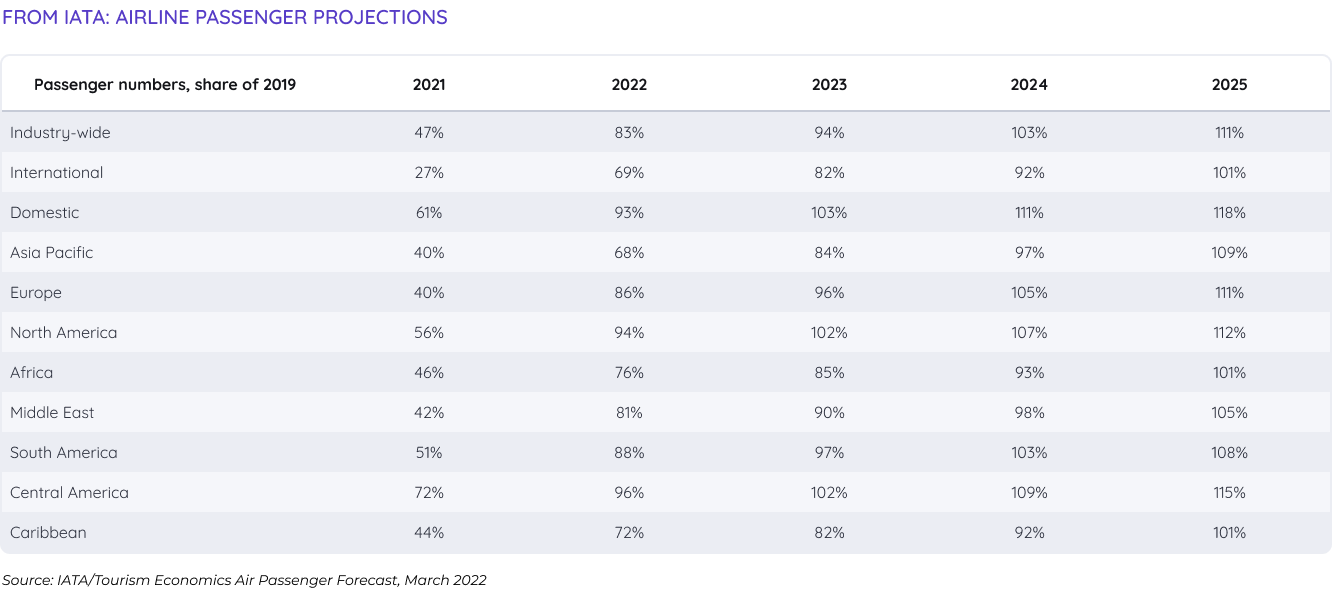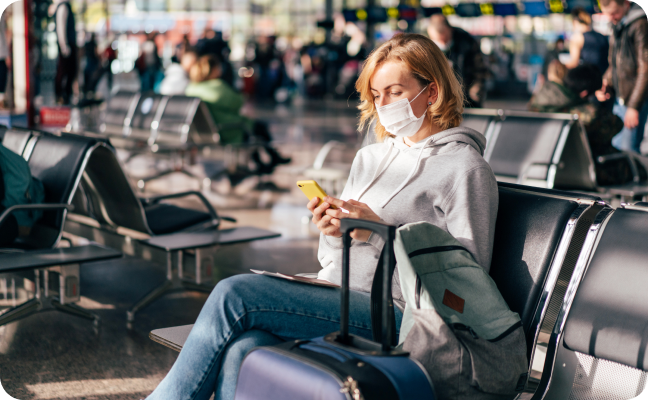Note: For purposes of clarity, when we refer to the airline industry, we’re talking about passenger travel on commercial flights. Although the travel industry and the tourism industry are interlinked, they are not the same. While the travel industry includes tourism, it is broader because it covers travel purposes beyond tourism.
This industry guide will address people’s travel from one place to another via road, rail, air and water and the various services they use in that process.
Types of online purchases for the travel & airline industry:

Flights

In-flight purchases

Travel vouchers

Rental cars

Touchless payments
Global Revenue Picture
The Economics Observatory reports that prior to COVID-19, travel and tourism accounted for 10% of global GDP (approximately 4.7 trillion United States dollars) and over 320 million jobs worldwide, making it one of the most important sectors of the world economy. Air passenger revenue in the global aviation industry had grown from about 374 billion USD in 2009 to around 607 billion USD in 2019, according to Statista.
The Pandemic Descent
When quarantine restrictions were enacted and the world came to a standstill, few industries felt the impact as painfully as airline and travel. Global airline scheduled passengers fell from 4.8 billion in the beginning of 2020 to 1.7 billion for the rest of the year, with The International Air Transport Association (IATA) stating that the “crisis challenged the industry for its very survival.”
Even today, the industry is struggling to regain its previous capacity, with delays and cancellations plaguing airports worldwide. The Airports Council International (ACI) estimated that in 2022, the COVID-19 crisis removed more than 3.6 billion passengers during the year compared to the projected baseline, representing a 35.5% decline in global passenger traffic.
- The Middle East will remain the most impacted region due to its dependence on international and transit passengers.
- Asia-Pacific passenger traffic in 2022 is 41.5% lower than that of the projected baseline. Because of the sheer size of Asia-Pacific’s market, the region is expected to record the highest traffic loss among all regions in 2022, seeing 1.59 billion fewer passengers than the projected baseline number.
- North America, on the other hand, will continue to outperform other regions, reaching more than 85% of its 2019 level by year-end.

Airlines were not the only segment of the industry to feel the impact.
RateGenius reports that the number of car rentals in the United States dropped significantly. In 2020, only 17.3 million cars were rented. That is a stark contrast to the 44.5 million rented vehicles the year before. Even after demand picked back up, rental companies found themselves competing for dwindling new-vehicle inventory.
Statista reports that as a result of the pandemic, the revenue of global leading cruise companies was substantially lower in 2020 and 2021 compared to pre-pandemic levels. Revenue of Carnival Corporation & plc fell by nearly 91% over 2019 and the revenue of Royal Caribbean Cruises and Norwegian Cruise Line dropped by 86% and 90%, respectively.
Destination: Recovery
The World Travel and Tourism Council reports that following a loss of almost $4.9 trillion in 2020 (50.4% decline), travel and tourism’s contribution to global GDP increased by $1 trillion (21.7% rise) in 2021.
With hopeful (but watchful) eyes, the travel and tourism industries are looking to the future.
The estimates provided below all come with strong caveats that these numbers are assumptions. As the ripple effects of the pandemic continue to reverberate throughout this industry, changes are happening at a rapid clip, making any and all short-term predictions subject to revision.
- The Statista Mobility Market Outlook estimates that worldwide sales in tourism and travel will rise to 72% by 2025. The outlook, which includes cruises, package holidays, hotel stays and private vacation rentals, estimates “that by 2023 revenue will return to a pre-pandemic amount of over 730 million and soar to over 900 million by 2025, with a projected annual growth rate (CAGR 2022-2026) of 10.47%.”
- United States domestic travel and tourism spending is forecast to reach more than $1.1 trillion for the year, surpassing pre-pandemic levels by 11.3%.
- International traveler spending in the United States could see growth of $113 billion during the year, reaching nearly $155 billion, slightly below (14%) 2019 levels.
- Employment in the sector could also surpass pre-pandemic levels, reaching nearly 16.8 million jobs, above pre-pandemic levels by 200,000 jobs.
- 2022 projections by WTTC and Oxford Economics show the travel and tourism sector's contribution of nearly $2 trillion to the United States economy could outperform 2019 levels ($1.87 trillion) by more than 6%.
- The IATA expects overall traveler numbers to reach 4 billion in 2024, exceeding pre-COVID-19 levels.
- For airlines specifically, the ACI forecasts that under the current projection and taking into account the slower-than-expected fourth quarter of 2021, global passenger traffic is expected to recover to 2019 levels in early 2024.
Between 2021 and 2040, Statista reports the airline industry is projected to increase carriers' revenue passenger kilometers by more than 5%. Around the world, airline passenger projections also point skyward for 2024:

Clearly, the industry has reason for hope: After dining out, travel is the second thing people most wanted to spend money on when a lockdown ended. The fortunes of all segments of the travel sector are projected to improve. Rate Genius projects the car rental industry will not only recover but beat out 2019 rental numbers with estimates at 46.8 million in 2024 and 49.2 million by 2025. The Cruise Lines International Association (CLIA) forecasts that passenger numbers will not only meet but exceed pre-pandemic levels by the end of 2023.
What’s Changed?
Deloitte identifies some recent shifts in who’s traveling — and how — as the ripples left by the pandemic continue to reverberate:

Private rental adoption has surged
With entry restrictions easing and tightening, and new COVID variants popping up, the unpredictability of international travel has those hungry to escape the same four walls looking for getaway alternatives.
Those not ready to brave close quarters with others at hotels have taken the opportunity to travel to the controlled safety of a private rental property. In summer 2021, Deloitte reports that 28% of rental travelers stayed at a private rental for the first time during the pandemic. By Thanksgiving, the number rose to 43% of rental customers choosing a private rental for the first time during the pandemic.

Meet the laptop-lugging leisure traveler
The pandemic-driven rise in remote work has expanded the leisure traveler universe. Those who can work anywhere (as long as there is an internet connection) have greater flexibility on travel dates and above-average buying power, per Deloitte.
To serve the evolving needs of these remote workers and their likelihood to take more frequent trips, travel suppliers may consider subscription models, which have historically struggled due to low frequency of travel.

Younger and wealthier travelers lead the return
Deloitte notes there are emerging age- and income-driven patterns that can be expected to continue in 2023. Older travelers are showing heightened hesitance. And higher-income travelers are coming back at a much faster pace than those in lower income brackets. Younger and wealthier travelers are also most likely to take a digital-first approach to travel research and booking, and so will have high expectations for the ecommerce experience.
Home
Chapters
Contact





